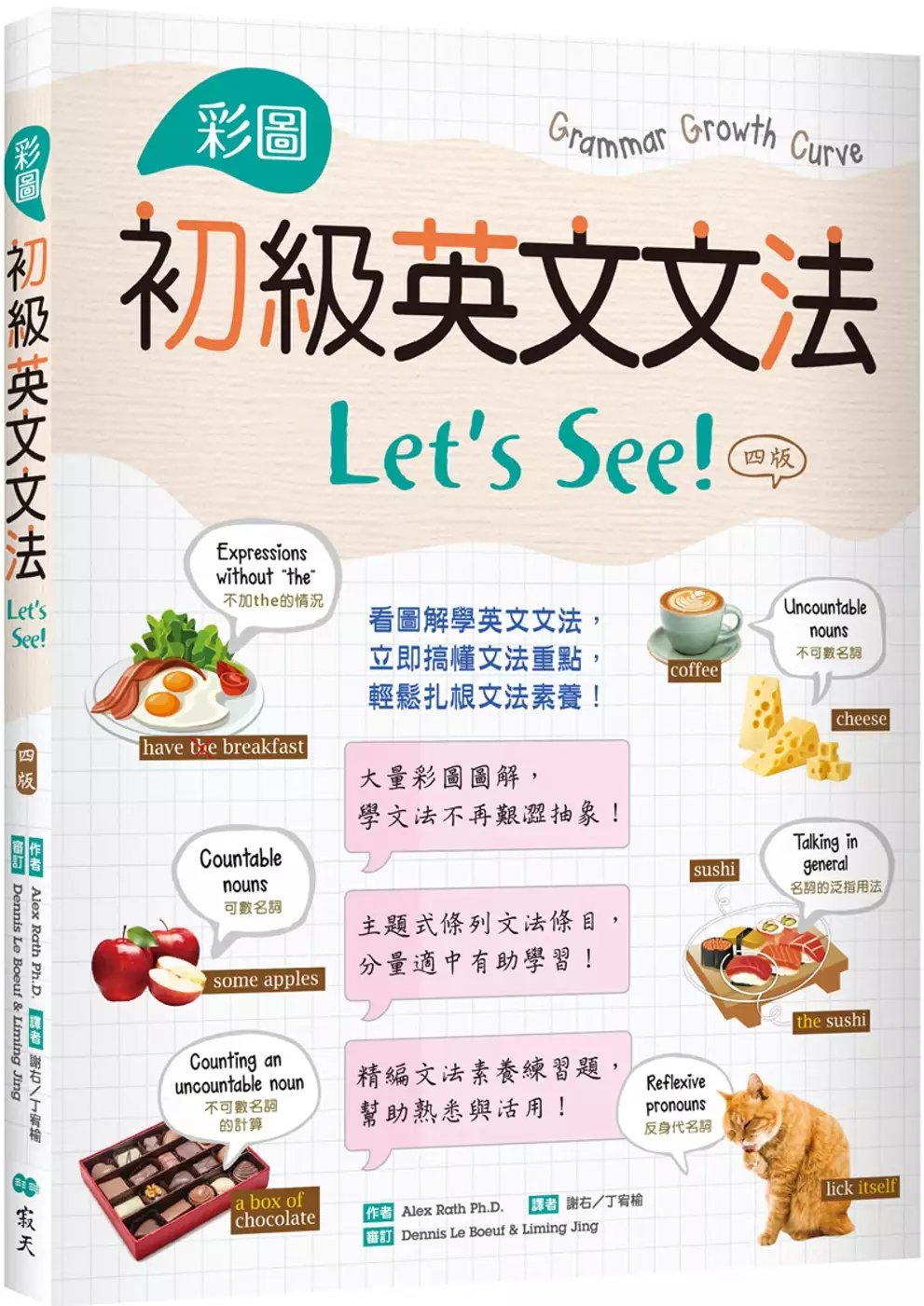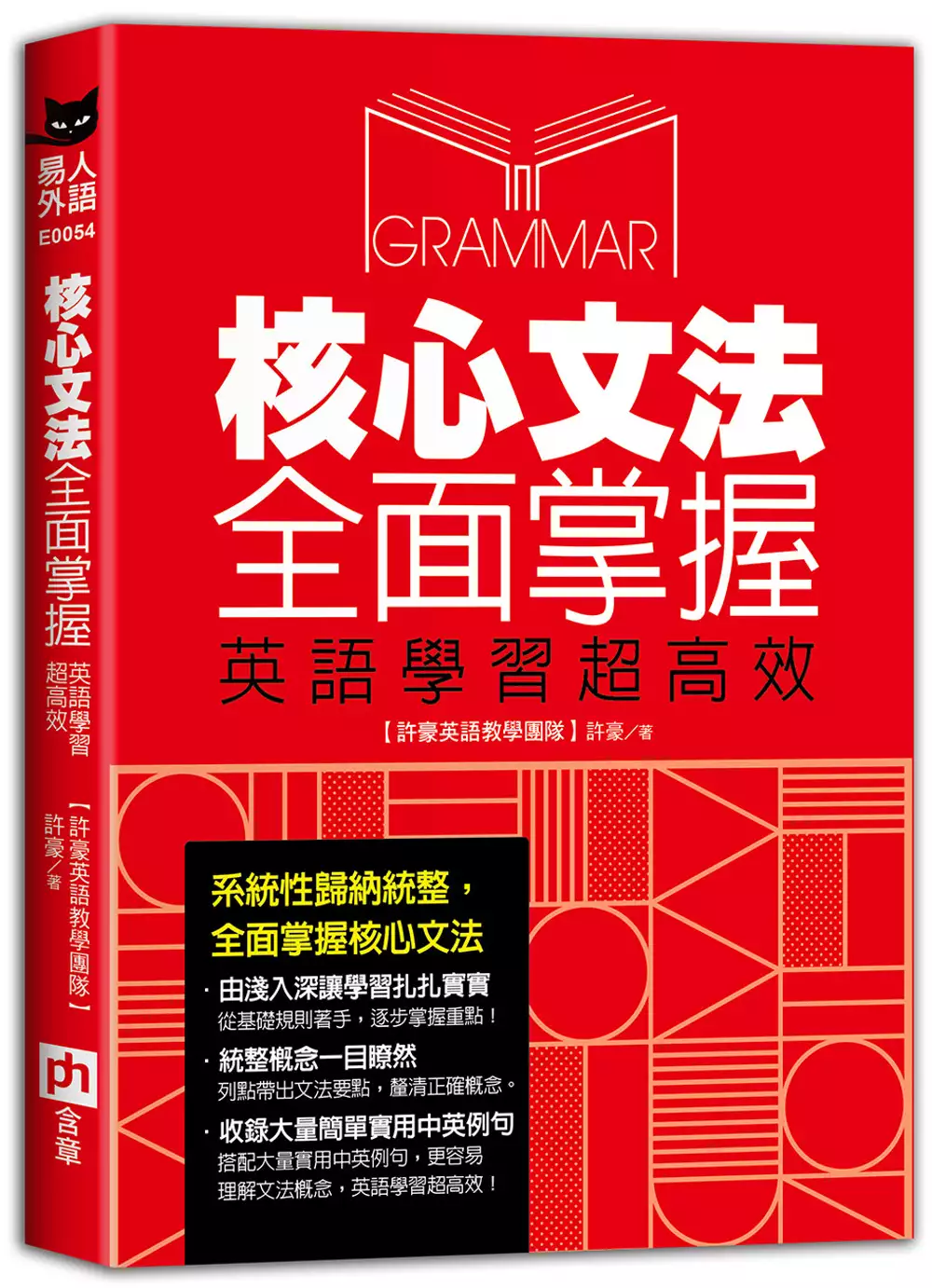simple past tense of的問題,透過圖書和論文來找解法和答案更準確安心。 我們找到下列包括價格和評價等資訊懶人包
simple past tense of的問題,我們搜遍了碩博士論文和台灣出版的書籍,推薦Alex Rath寫的 彩圖初級英文文法Let’s See!【四版】 (16K+解答別冊) 和許豪的 核心文法全面掌握,英語學習超高效都 可以從中找到所需的評價。
這兩本書分別來自寂天 和含章有限公司所出版 。
國立臺灣師範大學 英語學系 朱錫琴所指導 蔡思齊的 再探口語修正性回饋對第二語言習得成效之後設分析 (2021),提出simple past tense of關鍵因素是什麼,來自於口語修正性回饋、後設分析、調節變項、效果量、成效。
而第二篇論文國立臺灣師範大學 英語學系 詹曉蕙、齊莉莎所指導 理克的 語言、大腦與時間的相遇:漢語的觀點 (2021),提出因為有 漢語、構詞句法學、時間觀念、時貌、神經語言學、事件相關電位、類型神經語言學的重點而找出了 simple past tense of的解答。
除了simple past tense of,大家也想知道這些:
彩圖初級英文文法Let’s See!【四版】 (16K+解答別冊)

為了解決simple past tense of 的問題,作者Alex Rath 這樣論述:
用彩圖圖解學英文文法, 輕鬆搞懂文法重點,必學觀念一次掌握! 本書針對初級程度者編寫,涵蓋必學的重要文法概念,適合當作英文輔助教材,供課堂上補充使用,亦可用作自修教材。條列式文法解說內容深入淺出,搭配圖解簡單明瞭,並精心設計豐富多元練習題,幫助學生記憶與活用,從此搞懂英文文法! 本書特色 1.條列初級必學基礎文法 收錄初級必學的文法條目,難易度適中,並以主題式分類編排文法。循序漸進按步驟學習,讓初學者能夠輕鬆掌握核心文法概念。 2.一頁文法一頁練習,學完文法立即練習 每單元採對頁編排,左頁文法說明文法重點,右頁立即做練習,每單元分量適中好消化,學習進
度好安排,能聚焦學習重點,也能立即檢視學習成效。 3.列點說明好抓重點 各單元內的文法條目採條列式說明,清楚明瞭好吸收。一次搞懂一個觀念,讓初學者拋開煩雜的文法說明,不易混淆,艱澀文法也能輕易上手。 4.彩色圖解說明文法概念 上千張大量彩圖幫助學生用圖像式記憶學習文法,輕鬆理解記憶抽象文法概念,一次掌握必學文法觀念。 5.豐富例句幫助活用文法 文法概念編有豐富而多元的生活化例句,取材廣泛,舉凡運動、休閒、閱讀、飲食等,並用顏色標註文法重點字與解說,方便對照文法要點,理解更容易。 6.表格分析文法要點更好懂 大量採用表格式說明、歸納重點與進行比較
,讓初學者也能一目瞭然,有效捕捉重點資訊。 7.密集練習活用文法好簡單 佔全書一半分量的練習題,能讓初學者透過大量練習,在練習中學會文法運用於實際生活中,不用死背文法要點。練習題型多元活潑,且融入大量看圖作答題,以簡單、切中練習目標為主,幫助學生訓練與加強文法實力。 作者簡介 Alex Rath Ph.D. 出生於美國芝加哥,擁有伊利諾大學課程與教學博士學位(University of Illinois, Ph.D. in Curriculum and Instruction)。曾任教於國中、高中和各大專院校,1999年移居台灣,現在於世新大學英文系擔任副教授,曾出版
多本英文學習書籍。 Part 1 Nouns and Articles 名詞和冠詞 Unit 1 Countable Nouns: Plural Forms of Regular Nouns (1) 可數名詞:規則名詞的複數形(1) Unit 2 Countable Nouns: Plural Forms of Regular Nouns (2) 可數名詞:規則名詞的複數形(2) Unit 3 Countable Nouns: Irregular Nouns and Other Plural Nouns 可數名詞:不規則名詞與其他複數名詞 Unit 4 A, an 不定冠詞
Unit 5 A, an, the 不定冠詞和定冠詞 Unit 6 Uncountable Nouns 不可數名詞 Unit 7 Counting an Uncountable Noun 不可數名詞的計算 Unit 8 Talking in General 名詞的泛指用法 Unit 9 Proper Nouns 專有名詞 Unit 10 Expressions With and Without "the" (1) 加 the 與 不加 the 的情況(1) Unit 11 Expressions With and Without "the" (2) 加 the 與 不
加 the 的情況(2) Unit 12 Other Expressions Without "the" 其他不需要加 the 的情況 Unit 13 Possessive: ’s 所有格:’s Unit 14 Possessive: the . . . of . . . 所有格:the . . . of . . . Unit 15 Review Test of Unit 1~14 單元 1~14 總複習 Part 2 Pronouns 代名詞 Unit 16 Personal Pronouns: Subject Pronouns 人稱代名詞:主詞代名詞 Unit 1
7 Personal Pronouns: Object Pronouns 人稱代名詞:受詞代名詞 Unit 18 Personal Pronouns: Possessive Pronouns and Possessive Adjectives 人稱代名詞:所有格代名詞與所有格形容詞 Unit 19 Indefinite Pronouns and Adjectives: Some, Any 不定代名詞與不定形容詞:Some、Any Unit 20 Indefinite Pronouns and Adjectives: Many, Much, a Lot of, Enough
不定代名詞與不定形容詞:Many、Much、a Lot of、Enough Unit 21 Indefinite Pronouns and Adjectives: Little, A Little, Few, A Few 不定代名詞與不定形容詞:Little、A Little、Few、A Few Unit 22 Indefinite Pronouns: One, Ones, and Some Compound Pronouns 不定代名詞:One、Ones 與一些複合代名詞 Unit 23 Indefinite Pronouns: Someone/Somebody, Anyone
/Anybody 不定代名詞:Someone/Somebody 與 Anyone/Anybody Unit 24 Indefinite Pronouns: Something/Somewhere, Anything/Anywhere 不定代名詞:Something/Somewhere 與 Anything/Anywhere Unit 25 Indefinite Pronouns: No One/Nobody/Nothing/Nowhere, Everyone/Everybody/ Everything/Everywhere 不定代名詞:No One/Nobody/Nothing/N
owhere 與 Everyone/Everybody/Everything/Everywhere Unit 26 This, That, These, Those 指示代名詞與指示形容詞 Unit 27 Reflexive pronouns and "Each Other" 反身代名詞與相互代名詞 Each Other Unit 28 Review test of Unit 16~27 單元 16~27 總複習 Part 3 Present Tenses 現在時態 Unit 29 Present Tense of the Verb "Be" be 動詞的現在時態 Unit 3
0 There Is, There Are 有…… Unit 31 Have Got 「擁有」的說法:Have Got Unit 32 Present Simple Tense 現在簡單式 Unit 33 Present Continuous Tense 現在進行式 Unit 34 Comparison Between the Present Continuous Tense and the Present Simple Tense 現在進行式和現在簡單式用法比較 Unit 35 Verbs Not Normally Used In The Continuous Tense
通常不能用進行式的動詞 Unit 36 Review Test of Unit 29~35 單元 29~35 總複習 Part 4 Past Tenses 過去時態 Unit 37 Past Tense Of The Verb "Be" Be 動詞的過去時態 Unit 38 Past Simple Tense (1) 過去簡單式(1) Unit 39 Past Simple Tense (2) 過去簡單式(2) Unit 40 Past Continuous Tense 過去進行式 Unit 41 Present Perfect Simple (1) 簡單現在完成
式(1) Unit 42 Present Perfect Simple (2) 簡單現在完成式(2) Unit 43 Comparison Between The Present Perfect Simple And The Past Simple 簡單現在完成式和過去簡單式的比較 Unit 44 Review Test of Unit 37~43 單元 37~43 總複習 Part 5 Future Tenses 未來時態 Unit 45 Present Continuous for the Future 表示未來意義的現在進行式 Unit 46 "Be Going T
o" for the Future Be Going To表示未來意義的用法 Unit 47 Simple Future Tense "Will" 未來簡單式 Will Unit 48 Comparison Between "Will," "Be Going To" and the Present Continuous Will、Be Going To 和現在進行式的比較 Unit 49 Review Test of Unit 45~48 單元 45~48 總複習 Part 6 Infinitives And -Ing Forms 不定詞和動詞的-Ing形式 Unit
50 Infinitives (1) 不定詞(1) Unit 51 Infinitives (2) 不定詞(2) Unit 52 -Ing Forms 動詞的 –ing 形式 Unit 53 Purpose: "to . . ." and "for . . ." To 和 For 表示目的的用法 Unit 54 Review Test of Unit 50~53 單元 50~53 總複習 Part 7 Common Verbs 常用動詞 Unit 55 Go 動詞 go 的用法 Unit 56 Get and Take 動詞 get 和 take 的用法 Uni
t 57 Do and Make 動詞 do 和 make 的用法 Unit 58 Have 動詞 Have 的用法 Unit 59 Review Test of Unit 55~59 單元 55~59 總複習 Part 8 Modal Verbs 情態助動詞 Unit 60 Can Can 的用法 Unit 61 Could Could 的用法 Unit 62 Must Must 的用法 Unit 63 Have To Have To 的用法 Unit 64 Comparison Between "Must" And "Have to" Must 和 Have
to 的比較 Unit 65 May and Might May 和 Might 的用法 Unit 66 Should Should 的用法 Unit 67 Requests: May, Could, Can 表示請求的用語:May、Could、Can Unit 68 Offers and invitations: Would Like, Will, Shall 表示提供與邀請的用語:Would Like、Will、Shall Unit 69 Suggestions: Shall We, What Shall We, Why Don't We, Let's, How Abo
ut 表示提議的用語:Shall We、What Shall We、Why Don't We、Let's、How About Unit 70 Review Test of Unit 60~69 單元 60~69 總複習 Part 9 Types Of Sentences 句子類型 Unit 71 Affirmative and Negative Sentences 肯定句和否定句 Unit 72 Question Forms: Types of Questions and the Question Word "What," "Who" 疑問句:疑問句的種類和疑問詞 what
、who 的用法 Unit 73 Question Forms: “Who” and “What” Used As Subjects Or Objects 疑問句:who和what作主詞或受詞的用法 Unit 74 Question Forms: The Question Words "When," "Which," "Where," And "Whose" 疑問句:疑問詞 when、which、where、whose 的用法 Unit 75 Question Forms: The Question Words "How" and "Why" 疑問句:疑問詞 How 和 Why
的用法 Unit 76 Question Tags 附加問句 Unit 77 Imperative Sentences 祈使句 Unit 78 Review Test of Unit 71~77 單元 71~77 總複習 Part 10 Phrasal Verbs 片語動詞 Unit 79 Phrasal Verbs (1) 片語動詞(1) Unit 80 Phrasal Verbs (2) 片語動詞(2) Unit 81 Phrasal Verbs (3) 片語動詞(3) Unit 82 Review Test of Unit 79~81 單元 79~81
總複習 Part 11 Adjectives And Adverbs 形容詞和副詞 Unit 83 Adjectives 形容詞 Unit 84 Adverbs and Adverbial Phrases 副詞與副詞片語 Unit 85 Adverbs and Adverbial Phrases of Time and Place 時間副詞與地方副詞 Unit 86 Adverbs and Adverbial Phrases of Frequency and Manner 頻率副詞和狀態副詞 Unit 87 Comparison of Adjectives 形容詞的比較
級與最高級 Unit 88 Patterns Used For Comparison 表示「比較」的句型 Unit 89 "Too" and "Enough" With Adjectives and Adverbs too 和 enough 搭配形容詞與副詞的用法 Unit 90 Review Test of Unit 83~89 單元 83~89 總複習 Part 12 Prepositions 介系詞 Unit 91 Prepositions of Place : in, on, at (1) 表示地點的介系詞:in、on、at(1) Unit 92 Prepositi
ons of Place : In, on, at (2) 表示地點的介系詞:in、on、at(2) Unit 93 Other Prepositions of Place 表示其他地點的介系詞 Unit 94 Prepositions of Movement 表示移動方向的介系詞 Unit 95 Prepositions of time: in, on, at (1) 表示時間的介系詞:in、on、at(1) Unit 96 Prepositions of time : in, on, at (2) 表示時間的介系詞:in、on、at(2) Unit 97 Preposition
s of Time or Duration: for, Since (Compared with "ago") 表示時間的介系詞:for、since(與ago比較) Unit 98 Review Test of Unit 91~97 單元 91~97 總複習 Part 13 Conjunctions 連接詞 Unit 99 And, But, Or, Because, So 連接詞 and、but、or、because、so Unit 100 When, If, Before, After 連接詞 when、if、before、after Unit 101 Review
Test of Unit 99~100 單元 99~100 總複習 Part 14 Numbers, Time, And Dates 數字、時間和日期 Unit 102 Numbers: Cardinal Numbers 數字:基數 Unit 103 Numbers: Ordinal Numbers 數字:序數 Unit 104 Days, Months, and Years 星期、月分與年分 Unit 105 Time of Day 時間 Unit 106 Review Test of Unit 102~105 單元 102~105 總複習 Progress T
est Answer Keys
simple past tense of進入發燒排行的影片
0:00 簡介
1:00 點用呢條片
1:23 Simple present tense 簡單現在式
1:49 Simple past tense 簡單過去式
2:24 Simple future tense 簡單將來式
2:39 Present continuous tense 現在進行式
3:12 Past continuous tense 過去進行式
3:34 Future continuous tense 將來進行式
3:50 Present perfect tense 現在完成式
4:18 Past perfect tense 過去完成式
4:49 Future perfect tense 將來完成式
5:01 Present perfect continuous tense 現在完式進行式
5:19 Past perfect continuous tense 過去完式進行式
5:40 Future perfect continuous tense 將來完式進行式
5:59 注意地方
? Odysee 頻道 ► http://bit.ly/fla-odysee
? MeWe 專頁 ► https://bit.ly/fla-mewe
? MeWe 學英文群組 ► https://bit.ly/fla-mewe-group
?【成人英語再起步】網上課程 ► http://bit.ly/2We1n2Q
? Patreon 月費學習計劃 ► https://bit.ly/3fZcjID
? 哥倫布 12時態懶人包! ► https://youtu.be/tw9KEQLokjo
? 訂閱電郵通訊,收取學習資源、心得和課程最新消息 ► http://bit.ly/fla-nl
? 收聽 Learning English with Tiffany Podcast
► https://apple.co/2OwMPpK (Apple Podcasts) / https://spoti.fi/3g2KChF (Spotify) / https://bit.ly/3j0uSyd (Google Podcasts)
? 我的相機和其它拍攝器材 ► https://kit.co/finnieslanguagearts/canon-800d-rebel-t7i-youtube-kit
✏️ 歡迎提供字幕 :) ► https://www.youtube.com/timedtext_cs_panel?tab=2&c=UCHkPJ7O9LLjEntwbsgn5TOg
? Twitch ► http://bit.ly/fla-twitch
?? 英文 channel ► http://bit.ly/tiffanysuen-youtube
? 芬尼創業日記 channel ► http://bit.ly/fmkt-yt
感謝各位同學熱烈查詢,暫不設一對一、面授、小學和幼稚園學生為對象課程。

▶️ SUBSCRIBE 訂閱 ► http://bit.ly/flayt-sub
記住要按訂閱按鈕旁邊的小鈴鐺,那麼我們每次推出新片,你就會收到通知了!
It would mean the world to me if you could hit that bell ? beside the SUBSCRIBE button because that way, you get notified EVERY SINGLE TIME a new video goes live.
____________________________________________
▍WATCH MORE 收看更多:
名人英語 ► http://bit.ly/2EUc8QO
時事英語 ► http://bit.ly/2RqrMok
文法懶人包 ► http://bit.ly/2UPUzI4
品牌名學英語 ► http://bit.ly/2qd3mUq
語文知識 ► http://bit.ly/2GzuW8b
今天只學一個字 ► http://bit.ly/2DRQPgE
Word Pairs 怎樣分 ► http://bit.ly/2hS1MCF
____________________________________________
▍FOLLOW ME:
Instagram ► http://bit.ly/fla-ig
Facebook ► http://bit.ly/fla-fb
MeWe ► https://bit.ly/fla-mewe
Blog ► http://bit.ly/fla-medium
Twitter ► http://bit.ly/fla-twitter
Telegram ► https://bit.ly/fla-tg
Pinterest ► http://bit.ly/fla-pinterest
____________________________________________
Free stuff!!! :)
► Use my iHerb Discount Code: ASC7218
► Sign up at AirBnb and get HKD$290 in travel credit: https://www.airbnb.com/c/tiffanys213
► Get a FREE first Uber ride (up to HK$50): https://www.uber.com/invite/tiffanys2213ue
► Get TWO months of free SkillShare premium: https://skl.sh/2IIHhr8
► Get HKD$100 of credit to spend across your next 4 orders at Deliveroo: https://roo.it/tiffanyccs
► Get HKD$100 off your order at NOSH: TIFH437
再探口語修正性回饋對第二語言習得成效之後設分析
為了解決simple past tense of 的問題,作者蔡思齊 這樣論述:
儘管數十年來關於錯誤訂正的研究顯示出各種不同觀點,口語修正性回饋之成效仍未有定論。本研究藉由統合口語修正性回饋之實證研究,以檢測口語修正性回饋對於第二語言習得者發展之成效,並探討學習者特徵、研究設計以及口語修正性回饋相關變數等統計變項與其成效之相關性。本研究收集共計四十一篇發表於1988年至2018年間之初級研究,並整合分析了兩百零四個效果量。隨機效應模式分析結果顯示,口語修正性回饋對於第二語言習得發展影響達輕度至中度效果(g = 0.662),並證實了研究變項間存在異質性(????2 = 71.088%)。此外,於十三個調節變項中,學習者第二語言程度、目標語言、語境、實驗設計類型、目標語言
特徵、成效測量種類、研究時長、處置實施次數、出版形式、以及口語修正性回饋種類等十個變項為顯著調節變項。依據資料分析結果,本研究更針對教師、研究者及教育從業者提供教學上之建議與未來研究方向。
核心文法全面掌握,英語學習超高效

為了解決simple past tense of 的問題,作者許豪 這樣論述:
還在為英文文法問題苦惱嗎?你需要的解答都在這裡! 採列點式解說,破解學習盲點 囊括全方位文法知識, 學好文法,一本就夠! 詳盡文法解說,搭配實用生活例句 從基礎的音標、發音規則、詞性,到進階的關係子句、副詞子句等,本書囊括全方位文法知識,學好文法,一本就夠!並搭配大量實用生活例句,示範每一個文法重點如何實際運用,帶讀者快速看懂文法! 系統化整理,搭配表格釐清易混淆觀念 本書以系統性的方式編排,將核心文法分為「基礎篇」、「構詞篇」、「詞性篇」、「時態篇」、「語態篇」、「語氣篇」、「句式篇」及「特殊句型篇」,有效幫助讀者建立文法架構。並針對不同單元主題,以不同角度切入,採列
點式解說,有條理地逐步說明文法重點,讓觀念一目瞭然,清楚好吸收。再輔以表格幫助釐清易混淆觀念,建立正確文法觀念。 以理解代替背誦,將知識化為己用 跟著本書的脈絡系統性學習,徹底理解文法核心規則,讓英文文法如中文文法一般內化為己用,不必刻意背誦就能運用自如!
語言、大腦與時間的相遇:漢語的觀點
為了解決simple past tense of 的問題,作者理克 這樣論述:
時間被視為人類認知中至關重要的概念,時間標記則因語言而異。不過,大腦處理時間標記仍然不清楚。現今絕大多數的相關研究皆是針對印歐語系語言中的「時態」(tense)標記。本論文將要探討漢語中的「了」及「過」兩個「時貌」(grammatical aspect)標記和過去時間的關係,以及大腦如何處理「了」及「過」之時間標記。首先,本論文針對漢語中存在已久的「了」及「過」是否具有「時態」成分之辯論提供反證,並且主張「了」及「過」被用於表示過去時間是因為其時貌特徵。本論文將兩者時貌特徵與表示過去時間的關係分析成對應到不同語法的意義、功能:「了」對應到「時間先後關係」的認知功能,而「過」對應到「時間定位」
的認知功能。接著,本論文透過三個採用事件相關電位(event-related potential,稱ERP)技術的實驗測試/探討以上的分析。相關結果顯現了兩種質變上不同的效果進而支持上述分析:「了」在時間標記上的大腦處理誘發前腦及早期之負極性波幅(early frontal negativity),而「過」則是誘發晚期之正極性波幅(P600),此外,「了」及「過」在時間標記上的大腦處理方式與「了」及「過」在時貌上(非時間上)不同。最後,為使以上兩種大腦處理方式有廣義的且跨語言的功能解釋,本論文將漢語的時貌標記在時間上的大腦處理與印歐語系的時態標記在時間上的大腦處理方式做相互對比:前腦及早期之負
極性波幅(early frontal negativity)被視為反映「時間先後關係」的認知功能,晚期之正極性波幅(P600) 被視為反映「時間定位」的認知功能。總而言之,本論文採用以上分析及證據提供大腦如何處理時間標記之類型神經語言學模式。